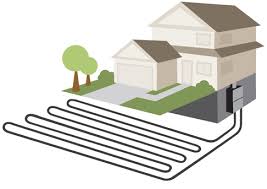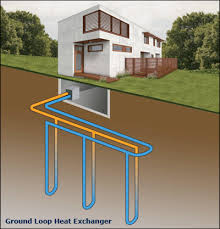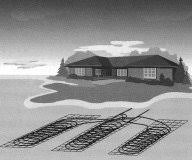Geothermal energy is the thermal energy generated and stored in the Earth. Thermal energy is the energy that determines the temperature of matter.
The geothermal energy of the Earth's crust originates from the original formation of the planet and from radioactive decay of materials.
Earth's internal heat is thermal energy generated from radioactive decay and continual heat loss from Earth's formation. Temperatures at the core–mantle boundary may reach over 4000 °C (7200 °F).
The high temperature and pressure in Earth's interior cause some rock to melt and solid mantle to behave plastically, resulting in portions of the mantle convecting upward since it is lighter than the surrounding rock. Rock and water is heated in the crust, sometimes up to 370 °C (700 °F).
Geothermal power is cost-effective, reliable, sustainable, and environmentally friendly, but has historically been limited to areas near tectonic plate boundaries. Recent technological advances have dramatically expanded the range and size of viable resources, especially for applications such as home heating, opening a potential for widespread exploitation. Geothermal wells release greenhouse gases trapped deep within the Earth, but these emissions are much lower per energy unit than those of fossil fuel.
Geothermal heating & cooling
Geothermal Heating and Cooling Systems provide space conditioning -- heating, cooling, and humidity control. They may also provide water heating -- either to supplement or replace conventional water heaters. Geothermal Heating and Cooling Systems work by moving heat, rather than by converting chemical energy to heat like in a furnace. Every Geothermal Heating and Cooling Systems has three major subsystems or parts:
- A geothermal heat pump to move heat between the building and the fluid in the earth connection, an earth connection for transferring heat between its fluid and the earth,
- A distribution subsystem for delivering heating or cooling to the building.
- Each system may also have a desuperheater to supplement the building's water heater, or a full-demand water heater to meet all of the building's hot water needs.
Geothermal Heat Pump
The geothermal heat pump is packaged in a single cabinet, and includes the compressor, loop-to
refrigerant heat exchanger, and controls. Systems that distribute heat using ducted air also
contain the air handler, duct fan, filter, refrigerant-to-air heat exchanger, and condensate
removal system for air conditioning.
For home installations, the geothermal heat pump cabinet is usually located in a basement,
attic, or closet. In commercial installations, it may be hung above a suspended ceiling or
installed as a self-contained console.
Distribution Subsystem
Most residential geothermal systems use conventional ductwork to distribute hot or cold air and to provide humidity control. (A few systems use water-to-water heat pumps with one or more fan-coil units, baseboard radiators, or under-floor circulating pipes.) Properly sized, constructed, and sealed ducts are essential to maintain system efficiency. Ducts must be well insulated and, whenever possible, located inside of the building's thermal envelope (conditioned space).
Geothermal heating and cooling systems for large commercial buildings, such as schools and offices, often use a different arrangement. Multiple heat pumps (perhaps one for each classroom or office) are attached to the same earth connection by a loop inside the building. This way, each area of the building can be individually controlled. The heat pumps on the sunny side of the building may provide cooling while those on the shady side are providing heat. This arrangement is very economical, as heat is merely being transferred from one area of the building to another, with the earth connection serving as the heat source or heat sink only for the difference between the building's heating and cooling needs.
Water Heating
Many residential-sized systems installed today are equipped with desuperheaters to provide domestic hot water when the system is providing heat or air conditioning. The desuperheater is a small auxiliary heat exchanger at the compressor outlet. It transfers excess heat from the compressed gas to a water line that circulates water to the house's hot water tank. In summer, when the air conditioning runs frequently, a desuperheater may provide all the hot water needed by a household. It can provide four to eight gallons of hot water per ton of cooling capacity each hour it operates. A desuperheater provides less hot water during the winter, and none during the spring and fall when the system is not operating.
Because the heat pump is so much more efficient than other means of water heating, manufacturers are beginning to offer "triple function," "full condensing," or "full demand" systems that use a separate heat exchanger to meet all of a household hot water needs. These units cost-effectively provide hot water as quickly as any competing system.
The water heating system that is installed in the Finger Lakes Institute is an on demand system. This system provides hot water as soon as there is a demand for it. Using this type of system eliminates the need to heat stored water like a conventional hot water tank requires. Types of Systems Geothermal systems use the earth as a heat source and heat sink. A series of pipes, commonly called a "loop," carry a fluid used to connect the geothermal system's heat pump to the earth.
Geothermal System - Closed and Open Loops

Open loop systems
Open loop systems are the simplest. Used successfully for decades, ground water is drawn
from an aquifer through one well, passes through the heat pump's heat exchanger, and is
discharged to the same aquifer through a second well at a distance from the first. Generally,
two to three gallons per minute per ton of capacity are necessary for effective heat exchange.
Since the temperature of ground water is nearly constant throughout the year, open loops are
a popular option in areas where they are permitted. Open loop systems do have some associated
challenges:
Some local ground water chemical conditions can lead to fouling the heat pump's heat
exchanger. Such situations may require precautions to keep carbon dioxide and other gases in
solution in the water. Other options include the use of cupronickel heat exchangers and heat
exchangers that can be cleaned without introducing chemicals into the groundwater.
Increasing environmental concerns mean that local officials must be consulted to assure
compliance with regulations concerning water use and acceptable water discharge methods.
For example, discharge to a sanitary sewer system is rarely acceptable.
Closed loop system
A closed loop system is being used for the Finger Lakes Institute. Closed loop systems are becoming the most common. When properly installed, they are economical, efficient, and reliable. Water (or a water and antifreeze solution) is circulated through a continuous buried pipe keeping. The closed loop system is environmentally friendly because water in the loop prevents contamination to the external environment. The length of loop piping varies depending on ground temperature, thermal conductivity of the ground, soil moisture, and system design. (Some heat pumps work well with larger inlet temperature variations, which allows marginally smaller loops).
Different Types of Closed Loops

Horizontal Loops
Horizontal closed loop installations are generally most cost-effective for small installations, particularly for new construction where sufficient land area is available. These installations involve burying pipe in trenches dug with back-hoes or chain trenchers. Up to six pipes, usually in parallel connections, are buried in each trench, with minimum separations of a foot between pipes and ten to fifteen feet between trenches.

Vertical Loops
Vertical closed loops are preferred in many situations. For example, most large commercial buildings and schools use vertical loops because the land area required for horizontal loops would be prohibitive. Vertical loops are also used where the soil is too shallow for trenching. Vertical loops also minimize the disturbance to existing landscaping. For vertical closed loop systems, a U-tube (more rarely, two U-tubes) is installed in a well drilled 100 to 400 feet deep. Because conditions in the ground may vary greatly, loop lengths can range from 130 to 300 feet per ton of heat exchange. Multiple drill holes are required for most installations, where the pipes are generally joined in parallel or series-parallel configurations.
A vertical loop well field, being used for the Finger Lakes Institute, consists of 20 wells, drilled to a depth of 100’. There are 5 (clusters) of 4 wells spaced approximately 12 feet on center, The depth and number of wells was determined by the estimated heat and cooling load required maintain a comfortable environment for the occupants.

Slinky Loops
Increasingly, "Slinky" coils -- overlapping coils of polyethylene pipe -- are used to increase the heat exchange per foot trench, but require more pipe per ton of capacity. Two-pipe systems may require 200 to 300 feet of trench per ton of nominal heat exchange capacity. The trench length decreases as the number of pipes in the trench increases -- or as Slinky coil overlap increases. (Illustration below shows a slinky coil in a pond).

Pond Loops
Pond closed loop are special kind of closed loop system, where there is a pond or stream that is deep enough and with enough flow, closed loop coils can be placed on the pond bottom. Fluid is pumped just as for a conventional closed loop ground system where conditions are suitable, the economics are very attractive, and no aquatic system impacts have been shown
GEOTHERMAL ADVANTAGES
Efficiency
Geothermal heat pumps are much more efficient than air source heat pumps because earth temperatures are much more uniform through the year than air temperatures. Not only are earth temperatures more constant, but also the range of temperatures in ground water is rather small in the United States, varying from upper 40s to upper 70s nationwide.
Geothermal Heating and Cooling Makes Sense
Geothermal systems are efficient, environmentally-sensitive, comfortable, and economical. Operating savings often provide paybacks of considerably less than five years -- sometimes less than two years. In addition, electric utilities are so convinced of the value of this technology for their customers that they offer design assistance, referrals, or financial incentives to defray the first cost increment of geothermal systems. The key is that geothermal heat pumps use electricity to move heat, not to generate it by the burning fuel or using electric resistance elements. Indeed, the U.S. EPA has found that no other technology with more favourable operating efficiencies and economics than emerging geothermal heat and cooling systems.
An Important Renewable Energy Technology
The U.S. Environmental Protection Agency has concluded that well-designed and properly installed high efficiency geothermal heat pump systems produce less environmental harm than any other alternative space conditioning technology currently available. On a full fuel cycle basis, emerging geothermal systems are the most efficient technology available, with the lowest CO2 emissions for minimum greenhouse warming impact. Overall, the EPA found emerging geothermal heating and cooling systems to have the lowest environmental cost of all technologies analysed -- including air-source heat pumps and natural gas furnaces.
Geothermal Heat Pump Systems Work!
No existing space conditioning technology offers greater comfort, economy, or environmental benefits than the geothermal heat and cooling systems now available for residential and commercial installations. Over 250,000 installations are in place in the United States today, and the number is rapidly increasing. More than 95 percent of all geothermal heat and cooling customers are completely satisfied with their systems.
Our Services
A commonly used example of geothermal design in facilities is the installation and operation of geothermal heat pumps (GHPs)—a central heating/cooling system that transfers heat to or from the ground which can be part of a new construction or retrofitted into an existing building. GHPs yield increased levels of occupant comfort while simultaneously lowering operating and maintenance costs when it comes to heating and cooling a building. Through our own experience and industry documentation, geothermal systems have been shown to reduce energy consumption of HVAC systems by up to 50 percent. Other uses have included domestic hot water heating, which may also increase the efficiency of the cooling cycle; refrigeration where savings can approach 70 percent over air cooled equipment; pool heating.
